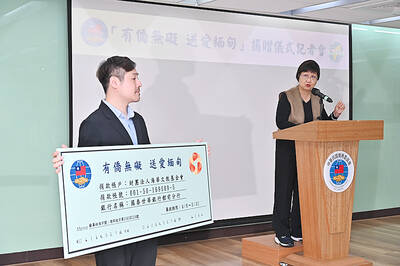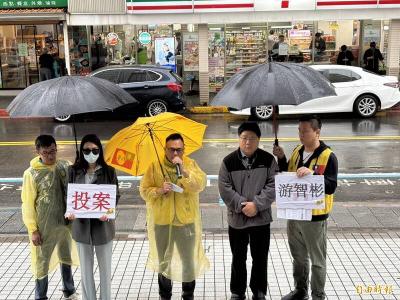Democratic Progressive Party (DPP) Chairperson Tsai Ing-wen (蔡英文) yesterday proposed decentralizing fiscal and political power to turn Taiwan into a multi-core nation with balanced regional development that would benefit the next generation.
The main theme of her policy on regional development is to “decompress” Taipei and the congested north and facilitate a “southward economy” that would benefit all Taiwanese, the DPP presidential candidate said in the second of a series of planned press conferences to unveil the DPP’s 10-year policy guidelines.
“Taiwan’s export and industrial production-oriented economy has over the years resulted in disparity between urban and rural areas; the northern and southern regions; as well as the eastern and western parts of Taiwan — and it ultimately created income inequality,” she said.
The glaring and worrisome disparity between different regions was the reason Tsai has proposed that the government should not invest all its resources in Taipei and the north, where about a quarter of the nation’s population resides.
The DPP intends to make a dramatic turnaround on national development policy, differing from that of President Ma Ying-jeou’s (馬英九), which Tsai said only focused on northern Taiwan and neglected other regions.
The northern and southern parts of Taiwan are facing different problems, she said, adding that while residents in the Taipei area enjoy more social resources and job opportunities, they are forced to endure a below-average quality of life.
Lack of efficiency in government funding under the Ma administration also contributed to the unbalanced regional development, Tsai said.
Tsai proposed transforming Taipei by funding large-scale urban redevelopment programs.
Local governments’ political power and fiscal power should also be expanded, Tsai said, so that they are able to play a lead role in regional development.
The new policy plans to develop key cities along the high-speed rail line into regional hubs and deploy new government facilities, institutions, corporate headquarters and innovative industries in central and southern Taiwan, former vice chairman of the Council for Economic Planning and Development Chang -Ching-sen (張景森) said.
The DPP will also be looking for possibilities to reshape the administrative areas to promote -better regional development, such as merging Hsinchu county and city as well Chiayi county and city, Chang said.
The Ma administration has always focused on development in northern Taiwan and intentionally blocks major projects in the south, Chiayi County Commissioner Helen Chang (張花冠) said.
“Yunlin County and Chiayi County represent the largest source of agricultural produce in Taiwan, but we always feel like we are the bottom-ranked counties because we have not been treated fairly by the central government,” she said.
Lin Chia-lung (林佳龍), a former Cabinet minister who is running for election in Greater Taichung, said central Taiwan “has been completely forgotten” by Ma and he proposed moving the legislature to Greater Taichung to “equalize” regional disparities and shift the center of power away from the capital.

DEFENSE: The National Security Bureau promised to expand communication and intelligence cooperation with global partners and enhance its strategic analytical skills China has not only increased military exercises and “gray zone” tactics against Taiwan this year, but also continues to recruit military personnel for espionage, the National Security Bureau (NSB) said yesterday in a report to the Legislative Yuan. The bureau submitted the report ahead of NSB Director-General Tsai Ming-yen’s (蔡明彥) appearance before the Foreign and National Defense Committee today. Last year, the Chinese People’s Liberation Army (PLA) conducted “Joint Sword-2024A and B” military exercises targeting Taiwan and carried out 40 combat readiness patrols, the bureau said. In addition, Chinese military aircraft entered Taiwan’s airspace 3,070 times last year, up about

A magnitude 4.3 earthquake struck eastern Taiwan's Hualien County at 8:31am today, according to the Central Weather Administration (CWA). The epicenter of the temblor was located in Hualien County, about 70.3 kilometers south southwest of Hualien County Hall, at a depth of 23.2km, according to the administration. There were no immediate reports of damage resulting from the quake. The earthquake's intensity, which gauges the actual effect of a temblor, was highest in Taitung County, where it measured 3 on Taiwan's 7-tier intensity scale. The quake also measured an intensity of 2 in Hualien and Nantou counties, the CWA said.

The Overseas Community Affairs Council (OCAC) yesterday announced a fundraising campaign to support survivors of the magnitude 7.7 earthquake that struck Myanmar on March 28, with two prayer events scheduled in Taipei and Taichung later this week. “While initial rescue operations have concluded [in Myanmar], many survivors are now facing increasingly difficult living conditions,” OCAC Minister Hsu Chia-ching (徐佳青) told a news conference in Taipei. The fundraising campaign, which runs through May 31, is focused on supporting the reconstruction of damaged overseas compatriot schools, assisting students from Myanmar in Taiwan, and providing essential items, such as drinking water, food and medical supplies,

New Party Deputy Secretary-General You Chih-pin (游智彬) this morning went to the National Immigration Agency (NIA) to “turn himself in” after being notified that he had failed to provide proof of having renounced his Chinese household registration. He was one of more than 10,000 naturalized Taiwanese citizens from China who were informed by the NIA that their Taiwanese citizenship might be revoked if they fail to provide the proof in three months, people familiar with the matter said. You said he has proof that he had renounced his Chinese household registration and demanded the NIA provide proof that he still had Chinese